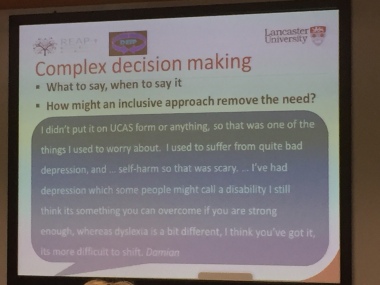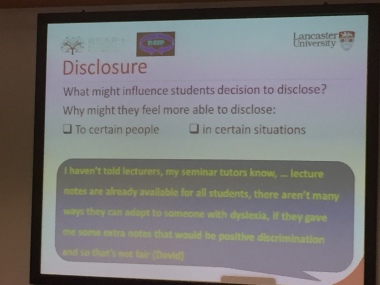
What is lurking anyway?
I call it consuming without contribution and we are all great digital consumers.
Truely, here and now in 2018, we risk Amusing Ourselves to Death
When Nicolas Carr (20080 asked Is Google Making us Stupid? interest in cognitive data overload was high. What happened to the CIBER research? The collaboration between Jisc and the British Library studied information searching behaviours in young people. Findings included short attention spans and reliance on surface browsing, with clear implications for universities in the future. Ten years on, those young people are likely to be our students. Today, I can’t even find the report online.
Show me embedded critical digital literacies and I’ll show you a dozen examples of uncritical acceptance.
Tell me why digital skills and confidence of staff who teach and support learning is absent from the ed-tech literature. We know how students learn as e-learners but staff who teach as e-teachers? Where’s that?
…and what’s all this got to do with lurking?
It’s scene setting. Part of the wider picture which starts and ends with our digital codependency and online habits.
Return to Lurking began Friday 13th July, 2018. The 24 hour #HEdigID discussion facilitated by @SuzanKoseoglu was still going strong on Saturday, Sunday, Monday, Tuesday…

The hashtag #OEP (Open Educational Practice) seemed a good opportunity to bring in digital shyness and the politics of participation persuasion. I introduced the concepts and before long lurking emerged as a theme.

I lurk. You lurk. We all lurk.
Lurking has intention and purpose.
Lurking as Learning is a path well-trodden. On 17th April this year, following the Digital Researcher run by my colleagues Mike Ewen and Lee Fallin, I wrote a post titled Sounds of Silence which addressed some of the emerging issues.
To lurk is to loiter, with or without intent, and not post.
Why?
Dunno.
We simply don’t understand enough about non-participation. We don’t know what’s going on behind closed screens.
Most of the time it simply doesn’t matter. We’re not expected to comment on every news article or blog post. The facility is available but there’s no pressure to use it.
It’s lurking in online courses which bothers me. Like in blended and distant learning courses where students consume without contributing. You can see content has been accessed but discussion or other collaborative activity fails.
Social constructivism is where it’s at these days. There’s Siemens’ Connectivism and Cormiers’ rhizomatic learning, but the majority of academic practice assumes a Vygotskian approach to how students learn, one which support knowledge construction through collaborative activity rather than didactic transmission.

Sometimes this takes place online and this is where digital silence worries me. Maybe it shouldn’t. But if students don’t talk, how can active learning progress?
So what next?
Well, maybe we’ve got it wrong.
The assumption (to borrow from Orwell’s Animal Farm) is participation good – non participation bad.
Yet we know from discussions, like those reported in Sounds of Silence and else where on Twitter et. al, there’s lots of positives to lurkish practice.
Some were highlighted during the #HEdigID diccussions.




However, lurking as negative remains a common perception as shown in the tweet below

while a 2018 paper by Sarah Honeychurch et. al., Learners on the Periphery: Lurkers as Invisible Learners, explores the lurking research literature. and makes some interesting suggestions. For example, the dominant mode remains that suggested by Neilsen in 2006, namely the 90-9-1 rule.
This rule posits that approximately 90% of group members consume content, 9% participate by contributing from time to time, leaving 1% to contribute a lot on a regular basis (Nielsen, 2006).
Then there’s the Pareto Principle, known as the 80/20 rule. Applied to online participation this translates as 20% of participants creating content which 80% consume.
It seems likely that to lurk is to inhabit safe space. Places of safety. Silent participation without risk. If so, then constructing lurking as a wrong to be righted is inappropriate. It may cause guilt and exacerbate fear of contribution rather than encouraging it.
The majority of Lurk-Lit focuses on change. The use of language like ‘converted’ and ‘persuaded’ suggests students need transforming from no-shows to show-offs, from passive to active.
But is this correct?
If 90% don’t contribute, or 80% consume, maybe we should look at non-contribution and consumption more closely.
Learning online is fundamentally isolated and lonely, but rather than stressing digital participation as a solution, maybe we should celebrate digital singledom instead.

When Philip Larkin wrote about the ‘unique distance from isolation‘ he was referring to a couple next to other in bed. The context is a difficult relationship, Something Larkin is so painfully good at.
If people can be so physically close, yet so far apart, maybe assumptions that distance means separation can also be challenged, Perhaps the isolated learner is more closely linked to a holistic experience of the module or programme, through the medium of digital resources, than we might think. It comes back to my introduction tweet to the #HE digID community.

We need a better understanding of digital shyness. Stop demonising those who choose not to express themselves, be it the digital public sphere or password protected university network. We need to look at lurking from the other side.
This was The Other Side of Lurking Part One; a unique distance from isolation
There is more in The Other Side of Lurking Part Two; dabbling with digital imposter syndrome which delves further into understadning lurking as a pedagogic strategy neding to be addressed in learning design.
taster below….
So lurking’s not a problem, right?
…but if it’s your virtual environment and you’re dealing with silence, it can’t be ignored. Lurking flies in the face of everything we’re told 21st century education should be, namely active. We’re well versed in communities of practice and inquiry, zones of proximal development, social, cognitive and teaching presences, and so on – and they all require interaction. Networks need people, don’t they?
visit The Other Side of Lurking Part Two; dabbling with digital imposter syndrome for more….
Images from #HEdigID discussion on Twitter or pixabay.com








 Wheel; A Model of Digital Pedagogy by Deborah Kelsey and Amanda Taylor. A slim little volume which packs a lot into its chapters. Well referenced and illustrated, it takes the core concepts of the Learning Wheel – Collaboration, Communication, Learning Content and Assessment – and applies them to the principle of digital pedagogy.
Wheel; A Model of Digital Pedagogy by Deborah Kelsey and Amanda Taylor. A slim little volume which packs a lot into its chapters. Well referenced and illustrated, it takes the core concepts of the Learning Wheel – Collaboration, Communication, Learning Content and Assessment – and applies them to the principle of digital pedagogy.









![allotment showing fence and greenhouse]](https://digitalacademicblog.files.wordpress.com/2017/05/alotment-greenhouse.jpg?w=438&h=329)





















 Slowly but surely places are emerging where education technology is aligning with academic practice. It seems a promising way forward. Why wouldn’t we want to introduce scholarship and pedagogy, build learning design around experiential loops of action research and appreciative inquiry? Lets shift the emphasis and make the future for higher education one which is more shaped by people rather than by machines.
Slowly but surely places are emerging where education technology is aligning with academic practice. It seems a promising way forward. Why wouldn’t we want to introduce scholarship and pedagogy, build learning design around experiential loops of action research and appreciative inquiry? Lets shift the emphasis and make the future for higher education one which is more shaped by people rather than by machines.




